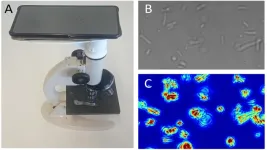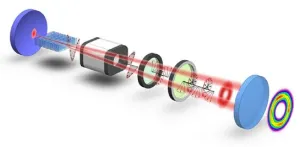Testing antibiotic resistance with a fast, cheap, and easy method
2023-04-24
(Press-News.org)
“We have developed a technique in our laboratories that allows us to obtain an antibiogram within 2-4 hours – instead of the current 24 hours for the most common germs and one month for tuberculosis,” says Dr Sandor Kasas at EPFL. Professor Ronnie Willaert at Vrije Universiteit Brussel adds: “Our technique is not only faster but also simpler and much cheaper than all those existing now.”
Antibiotic resistance happens when bacteria develop the ability to defeat the drugs designed to kill them. It has now grown into a global public health issue. It was responsible for at least 1.27 million deaths worldwide in 2019 while being involved in nearly five million deaths. Every year, the US sees almost three million antimicrobial-resistant infections, with the cost of treating the six most common ones at over $4.6 billion. The EU sees almost 700,000 cases each year, which cost it an estimated €1.5 billion.
Antibiotic sensitivity testing (AST) uses culture methods that expose bacteria to antibiotics, or genetic methods to determine if bacteria possesses genes that confer resistance. Typical ASTs last up to 24 hours or even longer for slow-growing bacteria – a timeframe that can mean life or death in a clinical setting. There have been some faster ASTs developed in recent years, but they tend to be complex, needing sophisticated and expensive equipment.
Now, researchers led by Kasas and Willaert have developed a fast, cheap, and widely accessible method based on optical microscopy that can perform an AST with single-cell sensitivity and without needing to attach or label bacteria. The technique uses a basic, conventional optical microscope, a camera or mobile phone, and dedicated software. The joint research project is published in PNAS.
The new technique is called optical nanomotion detection (ONMD), and involves the monitoring of nanoscale vibrations of single bacterial before and while being exposed to antibiotics. The monitoring is performed with a basic optical microscope, a video camera or a mobile phone.
The ONMD technique monitors the microscopic oscillations of bacterial cells (nanomotion) that characterize living organism and can be considered as a “signature of life”. Indeed, nanomotion lasts as long the organism is alive but stops immediately when it is dead. In the ONMD technique, bacterial nanomotion is recorded in a movie in which all individual cell displacements are monitored with sub-pixel resolution.
The researchers used ONMD to successfully detect the sensitivity of numerous bacteria to antibiotics. Escherichia coli, Staphylococcus aureus, Lactobacillus rhamnosus, and Mycobacterium smegmatis (a non-pathogenic bacterial model for tuberculosis) sensitivities to the antibiotics ampicillin, streptomycin, doxycycline, and vancomycin was determined in less than two hours.
The ONMD not only monitors the bacteria life-death transitions upon exposure to different antibiotics but also highlights changes in the bacteria’s metabolism caused by the availability of nutrients. The tests showed that ONMD can assess the sensitivity or resistance of bacterial cells to antibiotics in a simple and rapid way by monitoring cellular oscillations.
The authors state: “The simplicity and efficiency of the method make it a game-changer in the field of AST” as it can be applied to a wide range of bacteria, which has significant implications for clinical and research applications.
Other contributors
University of Lausanne (UNIL)
Reference
Maria I. Villalba, Eugenia Rossetti, Allan Bonvallat, Charlotte Yvanoff, Vjera Radonicic, Ronnie G. Willaert, Sandor Kasas. Simple optical nanomotion method for single-bacterium viability and antibiotic response testing. PNAS 28 April 2023. DOI: 10.1073/pnas.2221284120
END
[Attachments] See images for this press release:

ELSE PRESS RELEASES FROM THIS DATE:
2023-04-24
Targeting part of an antiviral pathway triggered by the accumulation of a key pathogen shared in Alzheimer’s disease and frontotemporal dementia may one day offer a new therapeutic approach to deterring or delaying cognitive decline, according to preclinical research led by Weill Cornell Medicine scientists.
The study, published April 24 in Nature Neuroscience, demonstrates that inhibiting an innate immune system enzyme called cyclic GMP–AMP synthase (cGAS) helps neurons become resilient to the build-up of the protein tau into bundles known as fibrils, a hallmark of Alzheimer’s and some forms of frontotemporal dementia, the two most ...
2023-04-24
Organic solar cells have a photoactive layer that is made from polymers and small molecules. The cells are very thin, can be flexible, and are easy to make. However, the efficiency of these cells is still much below that of conventional silicon-based ones. Applied physicists from the University of Groningen have now fabricated an organic solar cell with an efficiency of over 17 percent, which is in the top range for this type of material. It has the advantage of using an unusual device structure that is produced using a scalable technique. The design involves a conductive layer of tin oxide that is grown ...
2023-04-24
The 25th International Conference on Redox Medicine will take place on June 21-23 in Paris. Redox Medicine 2023 will provide a glimpse into the role of redox in tomorrow’s medicine.
What to Expect in Redox Medicine 2023?
Reactive oxygen species (ROS) have been studied for decades, but the results remain controversial. ROS are beneficial to biological mechanisms, acting as signaling molecules and enhancing immune defense. However, they also have harmful effects, such as causing tissue and organ damage.
Dr. Carole Nicco, stated that “The work and results presented at the Redox Medicine Congress will give ...
2023-04-24
Key takeaways
A study by researchers from UCLA, Australia, Ecuador, Germany, the Netherlands and the U.K. found that people around the world signal others for assistance every couple of minutes.
The research, which examined behaviors in towns and rural areas in several different countries, revealed that people comply with these small requests for help far more often than they decline them.
The findings suggest that people from all cultures have more similar cooperative behaviors than prior research has established.
A new study by UCLA sociologist Giovanni Rossi and an international team of collaborators finds that people rely on ...
2023-04-24
WASHINGTON, DC – The Department of Energy’s (DOE’s) Office of Science will sponsor the participation of 999 undergraduate students and 79 faculty members in three STEM-focused workforce development programs at 16 DOE national laboratories and a national fusion facility during summer 2023. Collectively, these programs ensure DOE and our nation have a strong, sustained workforce trained in the skills needed to address the energy, environment, and national security challenges of today and tomorrow.
“Our future depends on the next generation ...
2023-04-24
“One of the great mysteries of biology,” says Eric Libby, former SFI Postdoctoral Fellow, now an associate professor at the Integrated Science Lab (IceLab), Umeå University in Sweden, “is eukaryogenesis, or how eukaryotes arose.” Scientists consider this to be a period of major evolutionary transition, critical to our understanding of the history and evolution of life on Earth.
In a new study published on April 21, 2023, in PNAS, Libby worked with SFI Professor Christopher Kempes and Jordan ...
2023-04-24
The U.S. Department of Energy’s (DOE) Argonne National Laboratory has awarded its newest cohort of named fellowships, providing five early-career scientists with additional support as they pursue pivotal discoveries that will make Americans safer and better off and increase our understanding of the universe.
For 2023, the laboratory has named four Maria Goeppert Mayer Fellows and one Walter Massey Fellow. Maria Goeppert Mayer was a pioneering nuclear physicist who received the 1963 Nobel Prize in physics for discovering, at Argonne, the shell model of the atomic nucleus. Walter Massey ...
2023-04-24
Laguerre-Gaussian (LG) modes are a type of light wave that can carry the external torque of photons as they move through space. They are useful in many fields, from optical communications to super-resolution imaging. Advanced developments in these and other applications demand reliable and color-tunable LG mode laser sources, which do not yet exist.
An optical parametric oscillator (OPO) is a device that can generate a wavelength-tunable laser beam, so it has been used to realize a color-tunable LG laser source — generally, in one of two ways. One way is to change a regular beam into an LG beam using a phase component ...
2023-04-24
Every giant was once a baby, though you may never have seen them at that stage of their development. NASA’s James Webb Space Telescope has begun to shed light on formative years in the history of the universe that have thus far been beyond reach: the formation and assembly of galaxies. For the first time, a protocluster of seven galaxies has been confirmed at a distance that astronomers refer to as redshift 7.9, or a mere 650 million years after the big bang. Based on the data collected, astronomers calculated the nascent cluster’s future development, finding that it will likely grow in size and mass to resemble the Coma Cluster, ...
2023-04-24
Ithaca, NY--Mountain Quail are an under-studied but recreationally-valued management indicator species in California's Sierra Nevada. They are notoriously difficult to study due to their penchant for impenetrable, dense, shrubby habitats, high elevations, and steep slopes. In this study, researchers used 1,636 autonomous recording units across about 22,000 square kilometers to conduct the first ever systematic and comprehensive study of Mountain Quail habitat associations and fire ecology in the Sierra Nevada.
Researchers from the Cornell Lab of Ornithology, the University of Minnesota, Univesity of Wisconsin-Madison, and the ...
LAST 30 PRESS RELEASES:
[Press-News.org] Testing antibiotic resistance with a fast, cheap, and easy method







